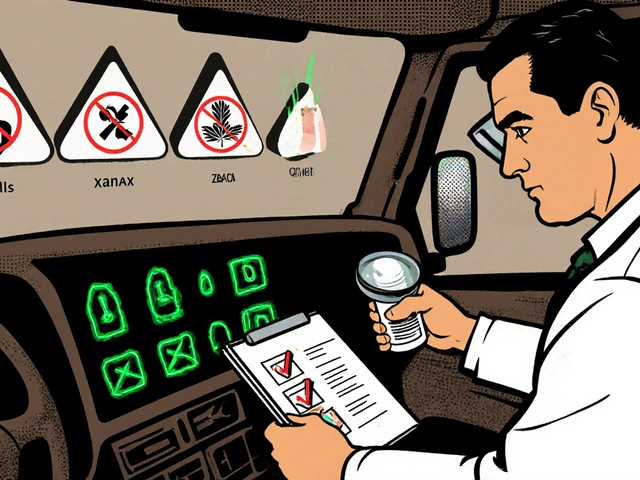
TL;DR
- This guide helps caregivers support a loved one on Lurasidone (brand: Latuda), a medication for schizophrenia and bipolar depression.
- Key rule: take it once daily with a meal of at least ~350 calories, at the same time every day.
- Watch for common side effects (sleepiness, restlessness, nausea) and red flags (sudden fever/rigidity, new suicidal thoughts, mania).
- Build a simple routine: dose-with-dinner, symptom tracking, pharmacy blister packs, and short weekly check-ins with the care team.
- In Australia, some uses may be PBS-subsidised-confirm the indication and script with a pharmacist or prescriber.
When someone you love starts lurasidone, the goal is steady recovery with fewer symptoms and a life that feels normal again. It’s doable. It also takes structure, patience, and a few evidence-backed tricks-especially with a medicine that works best with the right food and routine. I’ll walk you through what actually makes a difference at home: how to time the dose, what to watch for, how to respond to bumps, and how to protect your own energy without stepping back from support.
What caregivers need to know about lurasidone: the essentials that prevent problems
What it treats. Lurasidone is an atypical antipsychotic approved for schizophrenia and for depressive episodes in bipolar I disorder. In day-to-day language: it helps reduce hallucinations and delusions, and it helps lift bipolar depression without the heavy metabolic side effects seen with some other medicines. This is based on randomized trials and product information reviewed by regulators (think TGA in Australia and FDA in the U.S.), plus large prescribing guides like the Maudsley and major psychiatric guidelines.
Food matters more than you think. Lurasidone needs a decent meal to absorb properly. The manufacturer’s product information specifies a meal of roughly 350 calories or more. No, a cracker and tea won’t cut it. A bowl of Weet-Bix with milk and a banana, toast with peanut butter and yogurt, or dinner-sized portions all work. Many families lock in “dose-with-dinner.” It’s simple and improves consistency.
Dosing basics. It’s a once-daily tablet, typically in the 20-160 mg range depending on the person and condition. The prescriber will set the dose. Don’t split tablets unless advised. Avoid taking it on an empty stomach. Full benefits often show up over several weeks: small changes in 1-2 weeks, larger changes by weeks 4-6, and continuing improvement after that.
Side effects you might actually see. The common ones are sleepiness, restlessness or inner fidgetiness (akathisia), nausea, and sometimes stiffness or tremor (extra pyramidal symptoms). Compared with some others, lurasidone has a lighter footprint on weight, cholesterol, and blood sugar-but not zero. It has a low risk of affecting the heart’s QT interval compared to higher-risk antipsychotics, yet all antipsychotics can affect heart rhythm in some people. Product information and major guidelines agree on these points.
What interacts. Lurasidone is metabolised by CYP3A4. Strong inhibitors (like ketoconazole, clarithromycin, ritonavir) can raise levels. Strong inducers (like carbamazepine, phenytoin, rifampicin) can drop levels. St John’s wort and grapefruit are classic “just don’t” with meds that rely on this pathway. If a new antibiotic or herbal shows up, check with a pharmacist first. Alcohol can add to sleepiness and judgment issues-go easy or avoid.
Who should be cautious. People with significant liver or kidney issues often need dose adjustments. During pregnancy or breastfeeding, prescribers weigh benefits and risks-there’s no one-size-fits-all answer. Adolescents and older adults can be more sensitive to side effects. Don’t stop suddenly unless a doctor says so; abrupt stops can trigger relapse or withdrawal-like discomfort.
| Key point | Why it matters | Caregiver action | Typical range/notes |
|---|---|---|---|
| Take with food | Food increases absorption and effect | Anchor to dinner or a 350+ calorie meal | ~350+ kcal meal per official product info |
| Time to benefit | Expect slow, steady gains | Track weekly changes, not daily swings | 2-6 weeks for meaningful change |
| Common side effects | Sleepiness, restlessness, nausea | Note onset/severity; tell care team if persistent | Often dose-related; may ease after 1-3 weeks |
| Metabolic effects | Usually smaller than some peers | Support diet, activity; monitor weight/waist | Modest weight change on average in trials |
| Drug interactions | CYP3A4 inhibitors/inducers, grapefruit | Check new meds/herbals; avoid grapefruit | Clarify with pharmacist on each new script |
| Driving & machinery | Early sedation or dizziness possible | Avoid until you know the effect | Usually settles as the body adapts |
| PBS subsidy (AU) | Reduces out-of-pocket cost if eligible | Ask prescriber/pharmacist re: indication | PBS status varies by condition and criteria |
How this fits Australian care. In Australia, scripts may be subsidised under the PBS for specific indications-ask the GP, psychiatrist, or pharmacist to confirm. Dose administration aids (blister packs) are widely available at community pharmacies. GP mental health care plans and psychologist visits can be subsidised under Medicare. If you’re in WA, the Mental Health Act outlines rights and responsibilities, including for carers. No need to memorise the law-just know you do have a voice.
Bottom line for this section: a reliable meal plus a reliable time equals more reliable symptom control. If you only change one thing today, lock in the dose-with-dinner habit.

Build a daily support plan: routines, monitoring, and communication that actually stick
Your main job isn’t to be a mini-psychiatrist. It’s to set up everyday life so the medicine can work and the person you love can show up for their own recovery. Here’s a lean plan that covers the bases without turning home into a clinic.
Anchor the dose to an easy meal. Dinner works for most. If dinner is chaotic, choose a nightly snack instead. Real-life 350+ calorie ideas that aren’t a pain: a tuna sandwich with cheese; a bowl of pasta and sauce; Greek yogurt with muesli and honey; eggs on toast with avocado; or if you’re in a rush, a homemade smoothie with milk, oats, banana, and peanut butter.
Create a simple, repeatable rhythm.
- Same time daily: set a phone alarm titled “Dinner + tablet.”
- Set out the tablet with cutlery just before dinner-visual cue beats memory.
- Use a weekly pill organiser or ask for pharmacy blister packs (dose administration aids). They remove guesswork.
- Keep meds in a cool, dry spot-Perth summers can bake bathrooms and cars.
- Have water ready. Dry mouth can be a thing.
Track what matters, not everything. A one-minute log does more than a ten-minute diary you’ll quit. Use a note on your phone:
- Sleep: hours and quality.
- Mood: a simple 1-10 scale.
- Key symptoms: hallucinations, paranoia, or low energy.
- Side effects: sleepiness, restlessness, nausea, stiffness.
- Function: did they go to work/uni, shower, cook, see a friend?
Share that log at appointments. It gives the prescriber real-world data that beats memory (“I felt off last month, not sure when…”). Doctors adjust doses from patterns, not hunches.
Spot side effects early and respond in steps.
- Sleepiness: move dose closer to bedtime; simplify mornings; limit alcohol and sedatives.
- Restlessness (akathisia): describe it as “can’t sit still on the inside.” If it shows up, call the clinic-small dose tweaks or add-on meds often help.
- Nausea: always take with food; ginger tea or crackers can help; see the prescriber if it persists beyond a week or two.
- Stiffness/tremor: report promptly-these are extra pyramidal symptoms; prescribers can adjust the dose or add a helper medicine.
Red flags that need urgent attention:
- Sudden high fever, muscle rigidity, confusion, or heavy sweating-rare but serious (possible neuroleptic malignant syndrome). Seek emergency care.
- New or worsening suicidal thoughts or plans-urgently contact the care team or emergency services.
- A sudden flip into mania: little sleep but tons of energy, sped-up speech, risk-taking, grand ideas-call the prescriber promptly.
- Allergic reaction: hives, swelling, breathing trouble-emergency care now.
Missed dose playbook. If you realise the same evening, take it with food when you remember. If it’s next day already, skip the missed one-don’t double up. If multiple doses are being missed, that’s a system problem, not a willpower problem. Switch to blister packs, add alarms, or move dose time to something that always happens (like brushing teeth after dinner).
Talk so you both stay on the same team. Scripts help:
- When things are tense: “I’m not here to argue. I want us to get through tonight as calmly as possible. Can we eat first and talk after?”
- When asking about side effects: “Have you noticed any new restlessness or nausea since last week? If yes, let’s jot it down for the doc.”
- When motivation dips: “Would a 10-minute walk together help, or should we just put dinner on and rest?”
Plan your check-ins with the care team. Early weeks usually need more contact. A good rhythm:
- Week 1-2: brief phone check-in if anything feels off.
- Week 3-4: clinic review to adjust dose.
- Quarterly: weight, waist, blood pressure; bloods if requested (glucose, lipids, prolactin if indicated).
Keep documentation handy. Photos of scripts, a current med list, and a short symptom summary in your notes app. When a new doctor or pharmacist asks, you’re ready.
Cost and access tips (Australia-specific). Ask if the script qualifies for PBS subsidy for the diagnosed condition. If not, ask about alternatives with similar benefits that are PBS-listed for the same symptoms. Pharmacies in Australia can prepare dose administration aids, sometimes at low or no cost; ask your local pharmacist. If transport is tricky, ask about delivery.
Daily life boosters that make the medicine work harder:
- Sleep: aim for a stable bedtime, dim screens an hour before, and a cool room. If Perth’s heat is punishing, plan fans/AC early.
- Nutrition: steady meals beat perfect meals. Add protein and fibre. Limit heavy late-night caffeine that disrupts sleep.
- Movement: short, regular walks. Don’t promise gym marathons-consistency wins.
- Hydration: heat and antipsychotics can both dry you out. Keep water visible.
- Alcohol and cannabis: both can blunt progress and complicate side effects. Agree on small boundaries you can both keep.
Protect your bandwidth. Caregiving sprints are fine; caregiving marathons need pacing. Take turns if you can. Use short, predictable breaks for yourself. If things feel stuck, loop in the prescriber earlier rather than later.

Decision guides, checklists, and what to do when things wobble
This section gives you quick, plain-English tools for common forks in the road.
Quick decision guide: “Do we call the clinic now, or can it wait?”
- Call now: new suicidal thoughts; severe restlessness; sudden fever/rigidity/confusion; allergic reaction; fainting; new mania symptoms.
- Call within a few days: moderate nausea that persists >1-2 weeks; noticeable stiffness or shaking; sleeping all day; no improvement after 4-6 weeks.
- Self-manage and observe: mild sleepiness in week 1-2; mild nausea that eases with food; occasional lightheadedness when standing-hydrate and rise slowly.
Rule-of-thumb timelines:
- If side effects are mild and improving by week 2, keep going and monitor.
- If side effects are moderate and stable by week 2, book a review-dose adjustments help.
- If no symptom improvement by week 6, ask about dose changes or alternative strategies.
Caregiver checklist (save this):
- We have a fixed dose time anchored to a 350+ calorie meal.
- There’s a weekly pill organiser or pharmacy blister pack in use.
- An alarm reminds us daily.
- We track sleep, mood (1-10), key symptoms, and side effects in one note.
- We know the plan for missed doses and red flags.
- We’ve told the pharmacist about all meds, herbals, and grapefruit avoidance.
- We’ve scheduled a follow-up in weeks 3-4 to review effect and side effects.
- We have a short crisis plan: who we call, where we go, and what we bring.
What if adherence keeps slipping? People don’t skip meds for fun. Common causes: side effects, denial about illness, chaotic schedules, cost, or simple forgetfulness. Your moves:
- Problem-solve the cause before pushing reminders.
- Shift dose to the most reliable meal.
- Ask for blister packs so “Did I take it?” becomes obvious.
- Check for side effects quietly raising resistance; if yes, call the prescriber for options.
- Ask the doctor about once-nightly timing tweaks or, if needed, different meds. Lurasidone is oral only, but other antipsychotics have long-acting injections that suit some people.
Heat, dehydration, and Perth realities. In summer, a long bus ride after taking a sedating medicine is a recipe for wooziness. Plan the dose after you’re home for the evening, keep cold water handy, and don’t store tablets in a hot car. If someone feels lightheaded, sit, sip water, and rise slowly. If symptoms are severe or include fainting, seek medical care.
Food pairing shortcuts (because 350 calories sounds abstract):
- Two slices of wholegrain toast + avocado + boiled eggs.
- Yogurt + muesli + honey + banana.
- Tuna and cheese toastie + apple.
- Bowl of pasta with jar sauce + olive oil drizzle.
- Homemade smoothie: milk, oats, banana, peanut butter.
What to bring to appointments:
- Your 1-minute log (sleep, mood, symptoms, side effects, function).
- All current meds and doses (photo of boxes is fine).
- One clear goal for the next month (e.g., “Get back to two uni classes a week” or “Sleep before midnight”).
Talking to family and friends without oversharing. Agree on a simple line: “They’re on a new prescription. We’re focusing on routine, rest, and appointments.” You don’t owe anyone more info than that. Protecting privacy reduces stress, and that helps recovery.
Medication changes: what to expect. If the prescriber raises the dose, watch for a short-term bump in side effects (often a week or two), then reassess. If they add a helper med for restlessness, it’s usually short-term. If they switch medicines, ask about cross-taper-there’s a plan to avoid gaps or overlap issues. Don’t stop lurasidone abruptly unless told to.
Evidence quick-notes (why you can trust these tips):
- Randomised trials and product information show lurasidone helps with schizophrenia and bipolar depression, with a comparatively modest effect on weight and lipids.
- The “take with 350+ calories” requirement comes directly from manufacturer data and regulator-approved labels.
- Guidelines from major psychiatric bodies recommend monitoring side effects, metabolic markers, and functional recovery, not just symptom scores.
Mini‑FAQ
- How long before we know it’s working? You might see small gains in 1-2 weeks, clearer gains by 4-6 weeks. If nothing has shifted by week 6, talk dose or options.
- Can it make depression worse before better? Rarely, mood can wobble early. If suicidal thoughts appear or intensify, contact the care team urgently.
- Is weight gain guaranteed? No. Lurasidone is usually weight-neutral to modest weight change compared with some antipsychotics. Support with food and movement still matters.
- Can we split the dose? It’s designed as once-daily. Only split if the prescriber says so.
- Safe with antidepressants or mood stabilisers? Often, yes, but interactions vary. Always check the full list with the pharmacist or prescriber.
- What about alcohol? It can add to sedation and cloud judgment. Safer to avoid, especially early on.
- Grapefruit really a problem? Yes. It can change drug levels via CYP3A4. Skip it.
Next steps
- Set the daily routine now: pick the meal, set the alarm, and prepare the pill organiser.
- Start the 1-minute daily log tonight: sleep, mood (1-10), key symptoms, side effects, function.
- Book a check-in with the prescriber for weeks 3-4 to review early response and any side effects.
- Ask your pharmacist about blister packs and confirm interactions with any current meds or herbals.
- Draft a simple crisis plan: what counts as urgent, where you’d go, and who you’d notify.
Troubleshooting by scenario
- They refuse the dose tonight: keep it calm. Offer food first. Say, “Let’s just eat, and we’ll talk after.” If refusal continues for several days or warning signs appear, contact the prescriber.
- They feel extremely restless after a dose increase: call the clinic. Akathisia is fixable but miserable; don’t wait weeks.
- They’re too sleepy in the morning: confirm the dose is with dinner, not breakfast; discuss shifting closer to bedtime; review alcohol and other sedating meds.
- No change after a month: bring your log; ask about dose range, add-ons, or alternative treatments. It’s not failure-it’s tailoring.
- New antibiotic prescribed: before starting, ask the pharmacist, “Any issues with lurasidone?” Mention grapefruit and St John’s wort avoidance.
- Summer heat wave: move dose later, hydrate, plan quiet evenings, and store meds properly.
A quick word on caregiver wellbeing. You matter. Set two non‑negotiables for yourself each week-maybe a morning swim, a coffee with a mate, or a run around the block. Short breaks prevent blowups later. If you need support, ask the GP about carer resources, local peer groups, or counselling referrals. Services like Carer Gateway and mental health NGOs can help you navigate benefits and respite without you turning into a full-time administrator.
This isn’t about being perfect. It’s about small, steady moves that keep the rails under the journey: a reliable meal, a reliable time, clear notes, and quick calls when red flags show. From hot Perth evenings to rushed weekday dinners, those little systems are what make lurasidone safe, tolerable, and genuinely helpful.
Credibility notes
- Core facts here align with regulator-approved product information (TGA/FDA), large prescribing texts (Maudsley), and major guidelines for schizophrenia and bipolar depression (e.g., American Psychiatric Association, CANMAT/ISBD). Your prescriber’s advice always takes priority over general guidance.




Kimberly Ford
August 30, 2025 AT 05:50Just started this with my brother last week. Locking dose to dinner was a game-changer-he actually took it without a fight for the first time in months. Blister pack from the pharmacy? Lifesaver. Also, the 1-minute log? I’m using it. No more guessing if he’s ‘just being moody’ or if it’s the med. Small wins, but they add up.
jerry woo
August 30, 2025 AT 06:48Let me tell you about the real conspiracy here: Big Pharma doesn’t want you to know lurasidone works better with a damn banana and peanut butter toast than with some corporate-approved ‘nutritionally balanced’ shake. They’d rather you take it on an empty stomach so you blame the drug, not the idiot who forgot to feed the patient. Also, grapefruit? That’s not a warning-it’s a middle finger from Mother Nature to anyone who thinks science is a checklist.
Jillian Fisher
August 30, 2025 AT 09:15Does anyone else track mood on a 1-10 scale and then realize halfway through the week that they’re just projecting their own stress onto the person they’re caring for? I started doing it because the guide said to, but now I wonder if I’m making it worse by overanalyzing every sigh. Maybe I need to just… breathe more.
Rachel Marco-Havens
August 31, 2025 AT 05:24If you're not taking this with a full meal you're not just being careless you're endangering your loved one and frankly if you think a smoothie counts as 350 calories you need to open a nutrition textbook not a Reddit thread. This isn't a suggestion it's a medical requirement and if you ignore it you're not a caregiver you're a liability. Also stop using grapefruit like it's a health food it's poison with a rind.
Kathryn Conant
August 31, 2025 AT 07:27Stop overcomplicating this. Meal? Check. Time? Check. Log? Check. Blister pack? Check. Red flag? Call the doc. Done. You don’t need a PhD in psychopharmacology to be a good caregiver-you need consistency, courage, and the guts to say ‘no’ when your loved one says ‘I don’t wanna.’ You’re not their therapist. You’re their anchor. Show up. Every damn day.
j jon
August 31, 2025 AT 23:42I’ve been doing this for 18 months. The sleepiness fades. The restlessness gets manageable. The food thing? Non-negotiable. I used to feel guilty for needing a break. Now I know: I can’t pour from an empty cup. Five minutes of quiet with tea counts. You’re not failing if you’re tired.
Jules Tompkins
September 1, 2025 AT 04:28My cousin took this for a year. One day he just stopped. Said it made him feel like a robot. We didn’t know it was a red flag until he stopped showering and started talking to the ceiling fan. Don’t wait for a crisis. Watch the small stuff. The silence. The stillness. That’s when the real work begins.
Sabrina Bergas
September 1, 2025 AT 07:19350 calories? That’s arbitrary. Who decided that? The FDA? Some guy in a lab coat who’s never eaten a real meal? I’ve seen people on lower doses with better outcomes eating nothing but protein bars. This guide feels like corporate fluff wrapped in pseudoscience. Also, why is everyone so obsessed with ‘routine’? Life isn’t a spreadsheet. Maybe the real issue is forcing people into rigid systems instead of listening to their actual needs.
Patrick Ezebube
September 1, 2025 AT 22:55They told me to use blister packs. I said fine. Then I found out the pharmacy charges $15 for it. Meanwhile the guy who wrote this guide probably gets free meds and a Tesla. I’m not paying for a system that doesn’t pay me. This isn’t healthcare it’s a subscription service for guilt. Also I heard lurasidone was originally designed for mind control experiments. You think they’re really just trying to help? Or are they just testing how long we’ll take it before we break?